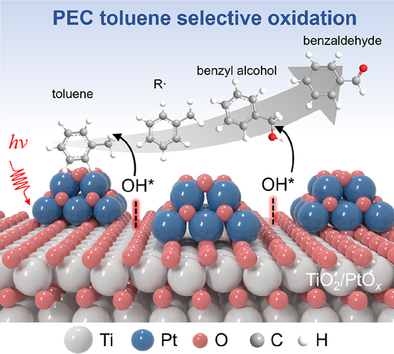Photoelectrocatalytic Activation of C─H Bond in Toluene by Titanium Dioxide-Supported Subnanometric PtOx Clusters
Graphical Abstract
Photoelectrocatalytic activation of C(sp3)─H bonds in hydrocarbon molecules to produce valuable oxygenates still suffers from the limited generation of reactive species and the weak adsorption of reactants. This study achieved the selective oxidation of toluene using a TiO2 supported subnanometric PtOx cluster (PtOx/TiO2) photoanode via an electrophilic OH*-mediated pathway. The modification of PtOx cluster can facilitate toluene adsorption and OH* generation, leading to the high efficiency of toluene oxidation.
Abstract
Selective oxidation of C(sp3)─H bonds via photoelectrocatalytic (PEC) strategy provides a promising approach to synthesize valuable oxygenates, but the efficiency of this process is still unsatisfactory due to the stable nature of hydrocarbon molecules. Herein, we report the PEC oxidation of toluene to benzaldehyde (BA) over a subnanometric PtOx cluster-loaded TiO2 (PtOx/TiO2) photoanode, achieving BA production rate of 1.75 µmol cm‒2 h‒1 with selectivity of 83.5% in aqueous medium, which is 4.4-fold higher than that of pristine TiO2. The strategy is also effective for the selective oxidation of toluene derivatives. As a proof-of-concept, we fabricate a self-powered PEC tandem device with S-shaped flow channels for the oxidation of toluene, producing BA with a productivity of ∼170 µmol under light irradiation. Experimental studies combined with density functional theory (DFT) results demonstrate that the toluene oxidation over PtOx/TiO2 photoanode follow an electrophilic hydroxyl species (OH*)-mediated pathway, which can suppress the over-oxidation of BA. Moreover, we reveal that subnanometric PtOx clusters promote toluene adsorption and OH* species generation, leading to the high efficiency of toluene oxidation. This work is expected to broaden the avenue toward the activation of C(sp3)─H bond under mild conditions in aqueous solution via a sustainable way.
Conflict of Interests
The authors declare no conflict of interest.
Open Research
Data Availability Statement
The data that support the findings of this study are available from the corresponding author upon reasonable request.





